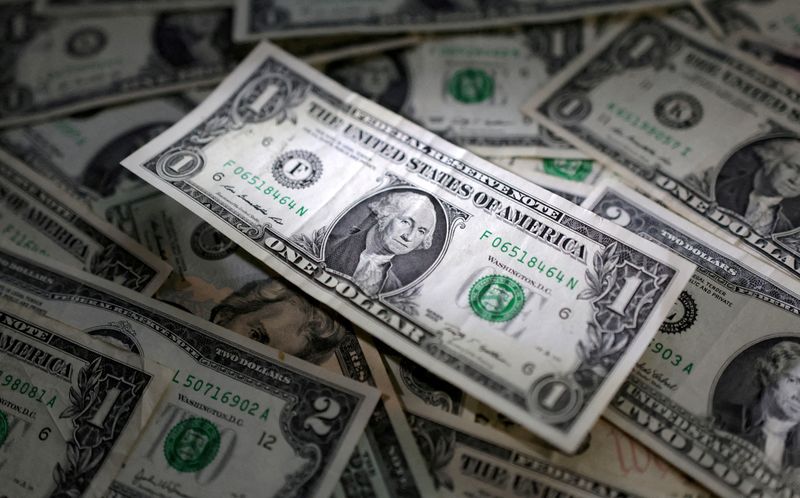Forex
Dollar falls to two-week low as economic data softens


© Reuters. FILE PHOTO: U.S. dollar banknotes are seen in this illustration taken March 10, 2023. REUTERS/Dado Ruvic/Illustration/File Photo
By Karen Brettell and Alun John
NEW YORK (Reuters) – The dollar dropped to a two-week low against the euro and a basket of currencies on Wednesday after data showed that U.S. private payrolls rose less than expected in August, adding to expectations that the Federal Reserve would stop raising rates.
Softening data this week has raised bets that the U.S. central bank has concluded its tightening cycle. It follows a brief increase in expectations for a November rate hike after relatively hawkish comments by Fed Chairman Jerome Powell on Friday.
This Friday’s jobs report for August will be closely watched for further confirmation that the tightness in the labor market is ebbing as interest rates remain relatively high.
“The dollar’s falling on the belief that the Federal Reserve has done enough,” said Adam Button, chief currency analyst at ForexLive in Toronto. “I think nonfarm payrolls will be the final ‘stick the fork in it’ moment if it’s soft.”
Friday’s jobs data is expected to show that employers added 170,000 jobs in August, according to the median estimate of economists polled by Reuters.
Private payrolls rose by 177,000 jobs last month, the ADP National Employment report showed on Wednesday. Economists polled by Reuters had forecast private employment would increase by 195,000.
The greenback also fell on Tuesday after data showed that U.S. job openings dropped to the lowest level in nearly 2-1/2 years in July as the labor market gradually slowed.
Markets now see a 91% chance of the Fed leaving rates unchanged next month, the CME FedWatch Tool showed, and a 43% probability of a hike in November.
The fell 0.54% to 102.97. It has fallen from 104.44 last Friday, the highest since June 1.
The greenback slipped 0.09% to 145.735 Japanese yen, backing away from a 10-month high of 147.375 on Tuesday, and reducing the likelihood that Japanese authorities will step in to shore up the ailing currency.
The euro bounced 0.54% to $1.0938. It has risen from $1.07655 on Friday, the lowest since June 13.
The single currency was boosted by hotter than expected inflation in Germany, a day before highly anticipated consumer price data for the euro zone.
The likelihood of the European Central Bank hiking rates in September may depend on Thursday’s numbers.
Money markets raised their bets on a September rate hike from the ECB, pricing in a 60% chance of a 25 basis-point move.
“A September hike at this stage could be more of a coin toss, but more importantly, we sense that the hawks will see it as a last chance to hike one final time,” said Benjamin Schroeder, senior rates strategist at ING.
Meanwhile, Australian inflation slowed to a 17-month low in July, reinforcing the case for the Reserve Bank of Australia to hold rates steady at its policy meeting next week.
The dollar was last up 0.54% at $0.6514, after earlier dropping to $0.64495 in the wake of the data.
========================================================
Currency bid prices at 10:15AM (1415 GMT)
Description RIC Last U.S. Close Pct Change YTD Pct High Bid Low Bid
Previous Change
Session
Dollar index 102.9700 103.5500 -0.54% -0.502% +103.7000 +102.9200
Euro/Dollar $1.0938 $1.0880 +0.54% +2.09% +$1.0946 +$1.0856
Dollar/Yen 145.7350 145.8700 -0.09% +11.16% +146.5300 +145.5600
Euro/Yen 159.42 158.71 +0.45% +13.63% +159.4900 +158.5600
Dollar/Swiss 0.8749 0.8784 -0.38% -5.36% +0.8803 +0.8746
Sterling/Dollar $1.2731 $1.2644 +0.70% +5.28% +$1.2746 +$1.2620
Dollar/Canadian 1.3531 1.3551 -0.14% -0.13% +1.3576 +1.3525
Aussie/Dollar $0.6514 $0.6480 +0.54% -4.43% +$0.6522 +$0.6450
Euro/Swiss 0.9569 0.9555 +0.15% -3.29% +0.9582 +0.9550
Euro/Sterling 0.8590 0.8603 -0.15% -2.87% +0.8610 +0.8586
NZ $0.6000 $0.5972 +0.48% -5.50% +$0.6006 +$0.5940
Dollar/Dollar
Dollar/Norway 10.5290 10.5680 -0.30% +7.36% +10.6260 +10.5330
Euro/Norway 11.5199 11.5070 +0.11% +9.78% +11.5760 +11.5000
Dollar/Sweden 10.7886 10.8672 -0.20% +3.66% +10.9097 +10.7814
Euro/Sweden 11.8022 11.8254 -0.20% +5.85% +11.8665 +11.7960

 Forex3 years ago
Forex3 years agoForex Today: the dollar is gaining strength amid gloomy sentiment at the start of the Fed’s week

 Forex3 years ago
Forex3 years agoUnbiased review of Pocket Option broker

 Forex3 years ago
Forex3 years agoDollar to pound sterling exchange rate today: Pound plummeted to its lowest since 1985

 Forex3 years ago
Forex3 years agoHow is the Australian dollar doing today?

 Cryptocurrency3 years ago
Cryptocurrency3 years agoWhat happened in the crypto market – current events today

 World3 years ago
World3 years agoWhy are modern video games an art form?

 Commodities3 years ago
Commodities3 years agoCopper continues to fall in price on expectations of lower demand in China

 Economy3 years ago
Economy3 years agoCrude oil tankers double in price due to EU anti-Russian sanctions





















